#cavy genetics
Explore tagged Tumblr posts
Note
What’s a dream animal you realistically could never own but you want so bad
if i was going to be the kind of person who owns non-reptile exotic animals i would have genets
i love genets so much. they are one of my favourite animals and they are apparently not terrible pets (for exotics) but ethical issues aside my life is just not one where i have the time space or spoons for a catweasel
i have the pelt of one though and it's the closest i'm sure i'll get
#questions#if a zoo has a genet you can bet your britches i'm staring at it#second choice: dikdik#edit: I FORGOT ABOUT PATAGONIAN CAVIES#those are actually like...kinda reasonable to have as pets though so idk if it counts
5 notes
·
View notes
Text

Midday on the Tharsis steppe brings cool, dry winds which blow in from the flanks of Pavonis Mons, dislodging a faint haze of dust into the air. Chewing placidly on rusty knotgrass stands a solitary Stilt-rhino, a rare visitor to this region of Mars from Ceraunius Fossae. It's shaggy bulk stands out in the treeless expanse, even if the cow is on the smaller side for Martian megafauna. Unlike many of the Rhinocerotidae descended from original stock brought planetside, all seven species are even more solitary than their terrestrial ancestors, meeting exclusively to mate on a three year cycle. Their incredible height, only possible under the lower gravity of their home, provides a high vantage point from which to catch scents.
Incredible as it may seem, this animal is actually taller than a bull African elephant of old Earth. Her fur, shorter on those namesake stilt legs, was ancestrally the result of genetic tampering. After determining a full climactic mimic of Earth was impossible, many late stage alterations to imported biota were hastily made in a vague mimicry of pleistocene species. In this case, both rhinoceros and elephants brought to the red planet were quickly furnished with serviceable coats. This trait is now universal among their descendants now found across the planet. Even equatorial species keep short, bristly coats.
Standing in the shadow of this colossus are members of a highly diverse family of deer-like rabbits, the cervoleporids. While low gravity and human bias left a perfect environment for larger mammals to firmly occupy megafaunal roles, these mostly forgotten rodents and lagomorphs, now free of medium sized animals, expanded immensely under lower gravity to capture every niche in size between dikdik to eland. Vast herds of never before seen rodents suspended eerily on wire-thin legs dance across the red plains, harried on occasion by packs of wolf sized rats or newly predatory cavies.
Had Linnean nomenclature, or indeed any zoologists survived to the modern day, these animals might have been Schreiber's Hartslaup. However, the bones of the last human scientist on Mars have long since been reduced to little more than mineralized shards. Thus they are simply Lesser Occidental Tharsis Hare-Antelopes. Physically, they're roughly the size of a Red Deer, with does sporting larger mustaches than bucks. Their reddened teeth (very few animals who did not receive an ancient tailored gene package to allow for skeletal iron sequestration have lasted long after the cities fell) are usually hidden except during threat displays. Like all Cervoleporids, they still retain four toes on all digits. The central pair have become hooves, while the outer two have shrunken and lost their nails entirely. They're hidden by hock feathering in this species.
These animals form opportunistic small groups, unlike their greater, or indeed much smaller kin. During the dry season, such as now, they fission off into pairs or quartets to reduce resource strain. The pair accosting our cow are taking advantage of a basic calculation; none of their normal predators would be stupid enough to attack near a stilt-rhino. For the most part, they're correct. The rhinoceros is not threatened by their presence either. She grazes on a wide variety of grasses, while Hare-Antelopes are selective browsers of shrubbery, and lower lying tuft grass.
During this snapshot in time, all three are at peace, something to be cherished on the Tharsis steppe. The vagrant cow will stand unmolested by her visitors, nudging them out of the way on occasion. The pair will alternate between keeping watch and lounging or eating until they part ways. So it goes, with life on Mars.
#worldbuilding#speculative evolution#history#speculative biology#mars#ink drawing#ink illustration#my art#Rusted soil
61 notes
·
View notes
Text
A useful guide on coat gene dominance patterns for guinea pigs.
1 note
·
View note
Text
What's up with my guinea pig?
Reaching out to guinea pig tumblr because I've just realized how weird Curie is and I'd like to see if anyone knows why she looks like this or could put me in touch with someone who knows more!

This is Curie. I have absolutely no idea where she came from. She was surrendered to the local shelter at around one year old with her pal/sister Frankie, so she was most likely originally a pet store pig.
The weird part is her fur! I have four other rescue pigs, and they all appear to be standard American pig in fur type. Curie is not a longhair, but her hair is noticeably longer than the others, especially noticeable with her the fur behind her ears, and much softer. It does not have the sheen of a satin, if anything I'd say it's duller than average. When all the pigs went to the vet recently she got comments on this, multiple vets at that office keep guinea pigs and they've never seen one like her!
On my other pigs, their black fur is very thick and shiny, and it's pure black all the way down to the root. On other animals, I would call this "extreme nonagouti", but it seems to be standard for solid pigs.

Here's Cori as an example. She's a black-and-tan. If her fur looks a bit lighter there, it's just because it's so reflective! It is really the same black all the way down, other than an odd gray hair.

Meanwhile, Curie's hair is definitely paler towards the roots. Again, I would find this amount of variation pretty standard for nonagouti in other animals, but with all my other nonagouti pigs being completely solid in color and no reported difference in extreme vs standard nonagouti, this seems odd.
She's much too old now to breed (and I wouldn't anyway, with her unknown origins, even if I were prepared to breed guinea pigs), so my only hope for finding out what's up is seeing if anyone else has had similar looking pigs. If they have, maybe I can improve the documentation on guinea pig genetics!
70 notes
·
View notes
Text
So the five freedoms of animal welfare are well known and great but I'm thinking we need additional freedoms for show animal breeders. A few "we can all agree" examples as well as a "grasping" example that people may not agree as much. I think it's fun and great to want to produce a beautiful animal but, I think in this day and age the animals we produce should be able to freely live comfortable, not shortened, lives. Open for any other ideas people have, tried to include lots of species.
1- Freedom from bred physical deformities: animals bred for fancy must not have physical deformities that impede quality or quantity of life. This includes skeletal and muscular deformities which disable animals from living and moving freely. example: pug dog, American fantail pigeon, Polish chicken (grasping example: giant dog breed with shortened lifespan, albino animals with reduced vision).
Freedom from known genetic deformities: fancy animals must be bred with the goal of avoiding traits connected to genetic deformities which shorten or impede quality of life. As well as tracked genetic diseases in species where you can do genetic screening. example: scottish fold cat, satin coated cavy, double merle dogs, feather duster budgie.
Freedom from human-caused mechanical harm. Fancy animals must not be manipulated in painful or unnatural ways in order to increase desirable qualities for the purpose of showing. Examples: big lick Tennessee walking horse, animal whisker trimming, feather plucking birds. (Grasping example: extreme long coated animals where mobility can be compromised).
205 notes
·
View notes
Note
I love the idea of colour mutations!!! It's one of my special interests. I used to breed budgies for the genetics (until my asthma said no) and have learned the every rabbit and budgie colour genetic! My two rabbits are a Pointed white Nethie doe (Jasmine) and yellow dutch doe (Amber). aa BB c(ch) c(ch) DD EE and A- BB CC D- ee dudu respectively. My fav colours are Lutino (birds, buns, reptiles etc), black otter (buns), blue merle (dogs), vitiligo and Tortie and white (cavy, cat, hamster, fish)
Yessss I have a friend who breeds rats and I will fully admit to feeling inspired by his talk about coat-pattern goals and all the different variations the little darlings can come out in! You have excellent taste in animal colors, those are all so beautiful 😍
6 notes
·
View notes
Photo
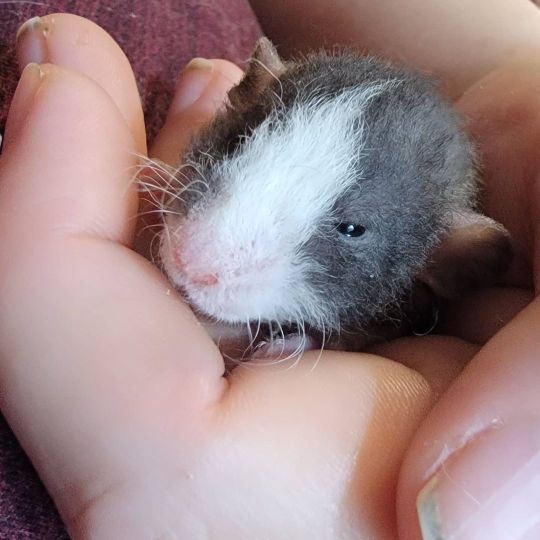
Look at this unreasonably cute baby rat! I'm ded of the cute. He looks like a tiny needle felted doll! Alright, now on to some not great news. We are at the point where The Pipsqueakery is shutting down all intakes (except a select few situations listed below). We are out of space, out of time, and our budget is currently stretched very thin. We have taken in over 250 animals in the last 2 weeks from very urgent situations (two situations that would have already doubled in numbers if we had not done a ton of emergency spays, and one situation at our other location) and it has stretched our resources to the breaking point. So, unless your surrender falls into one of the following situations your request will be indefinitely waitlisted: ❤ The animal is at a shelter we work with and in need of medical attention ❤ The animal is an unusual species that should not be rehomed to the general public including, patagonian cavies, capybaras, captive bred flying squirrels, groundhogs, prairie dogs, etc ❤ The animal is owned or found by an individual and in need of serious medical care. This is really only going to include things like broken limbs, paralysis, splays, serious genetic issues, dental disease, and other similarly serious ailments ❤ Returns. Animals adopted from us will always have a place here and must be returned to us Any other situations will need to seek out another rescue or contact your local shelter as we are just not able to accommodate anyone else at this point. If you want to help please consider donating or applying to adopt one of our many rats, guinea pigs, hamsters, and rabbits looking for a new home. If you would like to apply to adopt check out thepipsqueakery.org/adoption If you would like to donate there are lots of ways to donate including: ❤ Venmo: @ThePipsqueakery ❤ CashApp: $ThePipsqueakery ❤ Paypal: Paypal.me/thepipsqueakery ❤ Facebook: www.facebook.com/thepipsqueakery and use the donate button ❤ Patreon: patreon.com/thepipsqueakery ❤Amazon Wishlist: http://a.co/fEKocKc ❤ Chewy Wishlist: https://www.chewy.com/g/the-pipsqueakery-inc_b69832307 Thanks so much for your support through this difficult time. #rat #rescue https://www.instagram.com/p/CUDNpiZLB28/?utm_medium=tumblr
2 notes
·
View notes
Photo
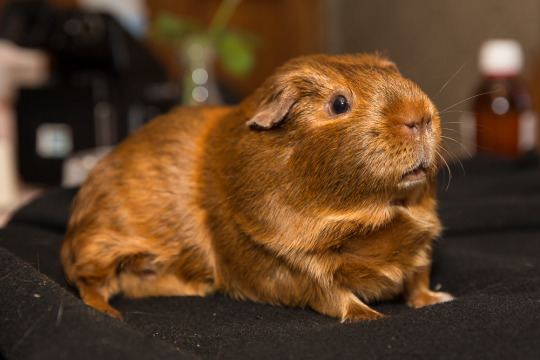

Satin Guinea Pigs (And Why You Shouldn’t Buy Them)
When you set out to learn about cavies it doesn’t take long for satin guinea pigs to pop up in your research, and with good reason! These hollow-haired absolutely stunning coat that shines and appears to have a glassy coating. This beauty, however, comes with a steep price.
Though satin guinea pigs aren’t a breed per se, several recognized guinea pig breeds (abyssinians, americans, peruvians, teddies and silkies) can present the satin gene. This recessive gene is linked to something known as satin guinea pig syndrome, an incurable genetic disease that can cause these animals extreme pain. SGPS or Fibrous Osteodystrophy is a metabolic bone disease that is characteristic of satin guinea pigs (and only satin guinea pigs).
Under normal circumstances, PTH (parathyroid hormone) is secreted as a response to low calcium levels. In order to raise calcium levels back to normal, it increases bone resorption (a process by which calcium is taken from the bones to raise levels in the blood stream). Usually this mechanism is balanced out by the action of the hormone Calcitonin which promotes the storage of calcium in the bones by reabsorbing calcium in the kidneys.
For piggies with SGPS, however, the reabsorption of calcium in the kidneys is highly inefficient. This chronic and significant calcium deficiency leads to an overactive bone resorption which causes bones to decalcify (osteoporosis) and form fibrous tissue to replace the boney matrix (osteitis fibrosa). This chronic degenerative disease is often diagnosed in young guinea pigs who go on to lead short, painful lives.
The skeletons of cavies with SGPS often present dental and skeletal deformities, kidney issues, hyperphosphatemia and hypocalcemia. Their weakened skeleton is highly susceptible to fractures. As the disease progresses walking will become progressively more difficult until it becomes impossible all together.
Breeding satin guinea pigs is a risky endeavor. Pregnant sows with the condition require extra calcium to produce milk and form fetal skeletons. This increased calcium requirement only works to accelerate the rate at which bone resorption occurs. This cause hypocalcemia, a disease expressed through seizures, paralysis and death. Even if the sow successfully carries her pregnancy and gives birth, milk production is equally taxing in terms of calcium requirement and presents the same risks as pregnancy. Because of this, mortality rates for sows with SGPS during or shortly after pregnancy are very high. As for the the babies, low calcium content in their mother’s milk will lead to hypocalcemia in them as well. Because of this they are often smaller than others of their kind.
SGPS currently has no cure. Though some owners choose to administer supplemental calcium, there is no evidence that this helps prevent or cure SGPS. Vitamin D3 plays a significant role in the reabsorption of calcium in the kidneys, because of this it’s beneficial to provide guinea pigs with SGPS with a UVB bulb to help prevent D3 deficiency and help delay the advancements of this disease. The best thing you can do for a piggy with this condition, however, is just to help manage their pain. Regular x-rays and vet visits will be necessary to check on the spread of the disease but once the bones are completely decalcified the only humane option is to put them down.
So please, do not buy satin guinea pigs. Be it from a breeder or a pet store you encourage the breeding of sick animals. I would only ever recommend getting a satin guinea pig if you’re adopting one from your local rescue, but always keep in mind that you’re signing up to get attached to an animal with a tragically short and painful existence.
1 note
·
View note
Photo
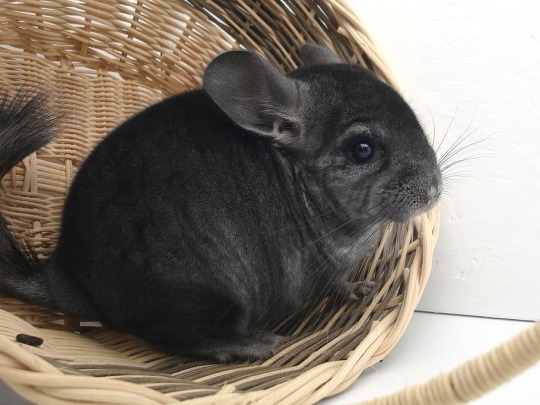
What's The Average Chinchilla Lifespan?
Chinchillas have a reputation for being delicate and dying easily. But owners will tell you they can live for an awfully long time. So, what's the truth—how long do chinchillas live?
How long do chinchillas live as pets? The average lifespan of a chinchilla is 10-20 years. The oldest chinchilla ever lived to 29 years and 229 days. This is longer than almost any other rodent, and is remarkably long for such a small animal. You can help your chinchilla live longer by feeding it the right diet, taking it for vet checkups, and ensuring its needs are met. The wild chinchilla lifespan is shorter at only ten years.
This is something you need to be prepared for if you want a pet chinchilla. With good care, you could have your friend by your side for much of your life! Our guide below explains why a chinchilla has such a long lifespan, and how to care for your pet to make it live longer.
How Long Do Pet Chinchillas Live?
The pet chinchilla's average lifespan is a matter of debate. Scientific sources give different average lengths, although it seems that somewhere between 10-20 years is average if you care for your pet properly. So, for example, this paper states:
Another cavy-like rodent, the Chinchilla (Chinchilla lanigera), has a longer lifespan. The documented record for a chinchilla is 17 years, but chinchilla breeders claim that some of their pets have lived over 20 years. The chinchilla is similar in size and ecology to the guinea pig, but lives in barren regions at higher elevations, and may have fewer predators in the wild.
But other sources disagree. This one says:
Additionally, the chinchilla's docile nature and long lifespan (∼10 years in the wild; up to 15–20 years domesticated) make it suitable for short- or long-term studies.
So, what's the truth? How long does a chinchilla livein captivity? Experienced owners will tell you that a happy and healthy pet chinchilla should live for longer than 10 years, and perhaps up to 20. This is why we advise potential new owners to think very carefully before they adopt a chinchilla. Can you afford to have a pet for this long? And will you want it for that long?
Why Did My Chinchilla Die So Young?
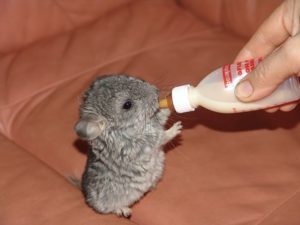
Not all chinchillas that die young are neglected, but all chinchillas that are neglected will die young.
Sometimes chinchillas have underlying genetic issues, or pass away in unfortunate accidents. This can be no fault of the owner. Even if you follow every care guide and tip, your pet could still die sooner than it should.
That being said, many owners do neglect their pets. Neglect comes in many forms: keeping a chinchilla in a cage that's too small, forgetting to give it pellets or refresh its hay, not giving it anything to do, and not giving it company or spending time with it are the most common. Stress, loneliness and poor diet can all contribute to an early passing. But if your chinchilla got to 10 years old, that's a good age for it to have reached.
If you aren't sure why your chinchilla passed away, ask a vet about a 'necropsy'. This is like an autopsy for pets. The vet will perform exploratory surgery to find whatever was wrong with your chinchilla's health. Discovering the problem can help you care for your remaining pets or future pets better, so we advise having one done if possible.
If you were looking after a chinchilla kit and it passed away, it may not have been your fault. Sometimes animals simply fail to thrive and will pass away before they are mature. This is the sad side of caring for baby chinchillas, and it's something you have to be prepared for if you want to breed chinchillas.
Why Do Chinchillas Live So Long?
Lifespan is normally related to the size of the animal: the bigger, the longer it will live. But chinchillas clearly break this rule as they're the same size, under all that fur, as animals that have a lifespan ten times shorter.
There are many other factors associated with age. Researchers at the University of Liverpool found that there's a protein produced in the body which fights aging; in some animals, this protein can be changed over the course of a lifetime to combat aging in ways that we don't fully understand. Meanwhile, other scientists point to the idea that total energy expenditure over a lifetime is related to longevity.
Generally speaking, animals that develop more slowly also have longer lifespans. This definitely applies to chinchillas: they develop in the womb for 110-111 days, and reach full maturity at around a year to a year and a half. This is much slower development than other animals of comparable size.
The truth is that we don't know exactly why some animals live longer than others. There seem to be all sorts of factors at play in a big, tangled web that doesn't make much sense. You'll know the moment we figure it out because the person who discovers the truth will probably patent it, and become the richest person on the planet!
Chinchilla Maximum Lifespan
The oldest chinchilla ever according to Guinness World Records was named Radar. He was owned by a German lady named Christina Anthony. Radar lived to an incredible 29 years and 229 days old. He was born on February 1st, 1985, and died on September 18th 2014. He moved with Christina to America in 2002.
It's unlikely that your pet will live as long as this. 20 years is the upper limit that most owners find. But with good care, it's possible!
What Rodent Has The Longest Lifespan?
The naked molerat is officially the longest-lived rodent in the world. These come from Africa, and the oldest ever recorded lived to be 32 years old. That's only a few years older than the chinchilla, meaning that the chinchilla's record is nothing to be sniffed at. For comparison, common rodents' maximum lifespans are:
Guinea pig: 14 years and 10 months
Mouse: 4 and a half years
Rat: 3 years or so
Squirrel: 15 years or so
So, in context, chinchillas can live to exceptionally old age.
How Long Do Wild Chinchillas Live?
Wild chinchillas don't survive for as long as their pet cousins. The generally accepted wild chinchilla lifespan is about 10 years. That's shorter than a pet chinchilla's lifespan because their diet is more variable; sometimes certain foods are available, and sometimes they aren't (depending on the season). And sometimes, there won't be as much food as there should be.
Predators are, of course, another issue. Chinchillas are a prey animal, and there are lots of predators that attack them. According to the San Diego Zoo, chinchillas can be predated on by owls and hawks from the air, or foxes and cougars on the ground. They do have some defense: they use their exceptional hearing to sense predators before they get too close. As they live in herds, when one chinchilla hears something, it will start barking and alerting the rest in the group. They all then run for cover.
There are also environmental factors to consider. While it only rarely rains, it does occasionally do so where chinchillas live, which makes life difficult for them; they can't get their fur wet or it gets moldy and matted. Fleas and worms are also common in wild chinchilla populations.
Long-Tailed Chinchilla Lifespan vs. Short-Tailed Chinchilla Lifespan
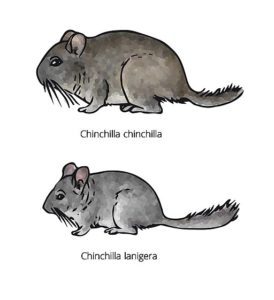
Image courtesy of Wikimedia.
The long tailed chinchilla is the kind that people have domesticated. It has a longer tail with sparser fur and a smaller body. If you look at it from above, its neck and shoulders are pinched in.
The short tailed chinchilla is rarer than the long tailed chinchilla in the wild. That's because they have thicker fur, so they were targeted by trappers. They also have blocks bodies and shoulders, so look more square from above. They also have smaller ears.
The lifespan of each species is roughly the same at ten years or so. Truth be told, scientists can't easily study either species because they're both endangered. Again, predators and environmental factors shorten their lifespan from its maximum length. But 10 years in the face of all of this is still highly impressive, and other rodents don't last anywhere near as long.
How to Make Your Chinchilla Live Longer
If you love chinchillas like we do, you'll want your pet to live longer. The best way to achieve that is to follow the basic care guidelines below. These won't cost you lots of money or take up lots of your time, and all experienced owners follow them.
Attention & Care
There is no substitute for good care, and no hacks and shortcuts you should take with your pet's health. Chinchillas have key needs that have to be accounted for, like food and water, space, interaction and vet care. You can't skimp on these things. If you do, your pet won't live as long.
Attentive time with your chinchilla is also important. This means giving your chinchilla the occasional check-up by picking it up and looking it over. You're looking for any sign of ill health, such as matted or damp fur, parasites, overgrown teeth, eye or mouth infections and so on. You should also check your chinchilla's cage to see that it's peeing, pooping and eating as it should be. While chinchillas like to keep it a secret if they're hurt or sick, it's better to check than to not check.
If you do catch a developing problem, you will get a head-start in treating it. A neglectful owner doesn't bother, and any condition that could have easily been treated early (like malocclusion) would instead become life threatening.
Correct Chinchilla Diet
Perhaps the most common mistake that owners make is feeding an incorrect chinchilla diet. Your pet's diet must reflect what chinchillas eat in the wild, which is mostly grass of various types. As such, pet chinchillas should eat almost nothing but hay and hay pellets. You may think they need more variety than that, but that's not true.
Another mistake is that people feed their chinchillas fruits or vegetables. These are unsuitable because they contain lots of water and lots of sugar. Chinchillas should have a diet that's very high in fiber with next to no sugar, so even 'healthy' fruit sugars are bad. The water can cause diarrhea, and the sugars will eventually cause weight gain.
The tough fibers in hay also may help keep a chinchilla's teeth from overgrowing. Owners are split as to whether they do, but the logic behind the idea makes sense. So, if you don't feed your chinchilla hay, it could affect its dental health too.
Frequent Vet Checkups
On top of checking your pet yourself, you should take it for frequent vet checkups. An experienced owner can spot a lot of things, but there's no substitute for a vet's eye. If possible, you should find a vet that exclusively treats exotic pets, as these vets will be more used to chinchillas than regular vets. Plus, there are lots of conditions a chinchilla can experience which need antibiotics or surgery, in which case you'll need to take them anyway.
Even though this represents a frequent expense, you will save money in the long run. That's because checkups are cheap ($30-50) while surgery is expensive (high three figure, or four figure sums). If this is too much of an expense, consider insurance, or perhaps a cheaper pet that doesn't need vet care.
Do Chinchillas Die Easily?
There are lots of ways a chinchilla can get sick or hurt itself. They aren't robust creatures; their rib cages and skeletons generally are flimsy and easy to break. They only look big because they have so much fur. This means they're vulnerable to physical trauma, so this is something you must remain aware of.
But as for health issues they can catch or develop, chinchillas aren't any more delicate than other rodents. With good care your chinchilla should stay happy and healthy for many years to come.
Below, you can find our chinchilla quiz, new posts for further reading, and a signup for our Chinchilla Newsletter!
#chinchillas #chinchillafaqs
0 notes
Text

In this post I am going to talk about the basics of this anything-but-basic animal.
TLDR; Guinea pigs are exotic animals with lots of breeds. Don’t breed or buy Satin pigs they have serious health problems, reacue them if you can afford the time and money for their specialized care.
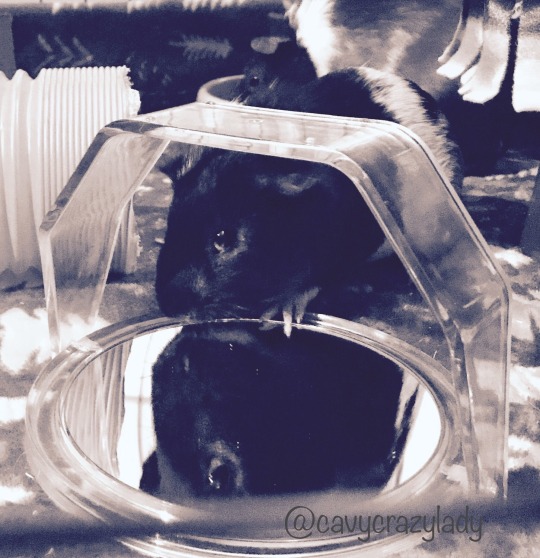

Guinea pig; domestic guinea pig; cavy; a pig by any other name would still smell like timothy hay. Male pigs are known as boars; females as sows; babies are referred to as pups, breaking from the porcine trend. Cavies are large rodents that originate from the Andes of South America and were originally domesticated as livestock.. for food.. and continue to be so in various South American countries. This blog, moving forward, will only cover guinea pigs as pets.
Pups are born about 3-4” in length and grow continuously until full maturity is reached around 14 months. An adult guinea pig can be anywhere from 8-12” in length and 1.5-2.6 lbs. Boars and sows must be separated as soon as 3 weeks after birth, guinea pigs reach sexual maturity very early and baby boars *will* impregnate Mom, sisters, and any sow that walks his little way. Sows have a limited time frame in which to safely reproduce; too young can cause complications, but around 10 months guinea pig pelvic bones start to fuse requiring a c-section for any chance of safe delivery for sow and pups.

There are 13 breeds of guinea pigs in various colorations that are recognized by the American Cavy Breeders Association (ACBA) among several unrecognized breeds. For the love of guinea pigs, the CavyCrazyLady does not recognize the ‘satin’ versions of any breeds (explained at the end of this post). I will cover specifics of breeds and colorations in a later post, including both recognized breeds and a few that are not:
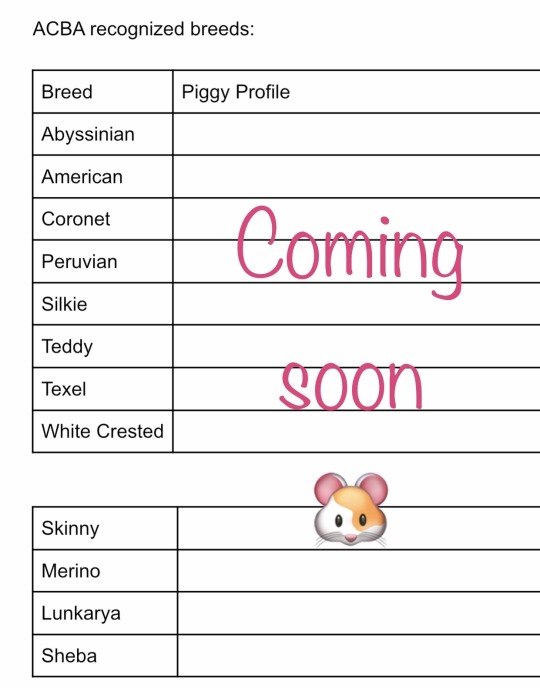

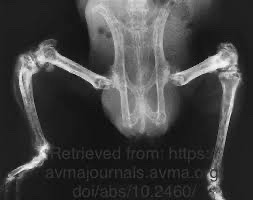
Okay. The reason that I do not recognize satin breeds is because it is cruel to intentionally breed pigs to obtain this ‘desirable’ coat. I am not a veternarian, but ‘Satin Guinea Pig Syndrome’ is a quick google away for anyone with internet. Satin coats are suspected to be a product of a genetic disorder. Most satin pigs live short, pain-filled lives often with bone and kidney diseases. Satin pigs are found to suffer from hyperparathyroidism and hormonal imbalances, fibrous osteodystropy, hypercalcemia, malocculusion, and lameness.
0 notes
Text
New Zealand Cavy Council Bans Breeding of Satin Cavies
This is a HUGE step in the right direction for the growing number small animal fanciers who care for the lives of their animals more than just their looks and prizes. Satin cavies are unhealthy animals yet shown in most countries. I think this is the first country which has taken a step in the right direction to eliminate the satin gene from cavies! Small animal breeders need to show the world that we love our animals, and we can’t do that when we knowingly breed ones that are diseased!
SATIN CAVIES NZ Cavy Council Update
There is evidence that a large amount of Cavies exhibiting the Satin gene suffer from a condition/s also known as “Satin Syndrome” This genetic disease is not curable.
After extensive consultation with breeders, exhibitors and judges in NZ we have found Satin Syndrome is present across both pet and purebred Satin Cavies in NZ.
The New Zealand Cavy Council believes that any continued support for the breeding and or exhibition of Satin Cavies would be unethical and breech both the New Zealand Cavy Council Codes of Conduct and Welfare.
We feel that the (below) proposals which come into effect 1st March 2020 manage the large responsibility placed on the New Zealand Cavy Council in a fair manner for those members breeding and exhibiting Satin Cavies and in a humane way for Satin Cavies.
The council understands that Cavies within some breeds may carry the Satin gene and are happy to support studs in this position to understand Satin genetics and manage their breeding going forward.
For anyone seeking clarification on any of the above feel free to contact the New Zealand Cavy Council.
The New Zealand Cavy Council www.nzcavycouncil.org.nz
Satin Cavies, in particular “Satin Syndrome” and the welfare of Satin Cavies has been a topic of much discussion within the New Zealand Fancy.
In 2019 a survey on Satin Cavies was sent to all NZ Cavy Council Members. The results of this survey were sent to all NZ Cavy Council members.
In January 2020 a council meeting to discuss Satin Cavies was set for 7th February 2020 at the NZ Cavy Council Conference, several proposals were received and sent to affiliated clubs for discussion and vote.
At the Satin meeting held 7th February 2020 the following 5 proposals were passed.
1. That from March 1st 2020 no New Zealand Cavy Council member shall breed from a Satin Cavy.
That from March 1st 2020 New Zealand Cavy Council members shall not knowingly breed any two Cavies together that carry the Satin gene.
That any Satin Cavy sold, gifted or moved into new ownership be accompanied by a New Zealand Cavy Council fact sheet on the Satin gene in Cavies & the care of Satin Cavies.
That any Cavy known to carry the Satin gene sold, gifted or moved into new ownership be accompanied by a New Zealand Cavy Council fact sheet on the Satin gene in Cavies.
That from March 1st 2020 no New Zealand Cavy Council affiliated Club or New Zealand Cavy Council show shall provide a class or section in any breed show for the exhibition of Satin Cavies.
2. That from March 1st 2020 no New Zealand Cavy Council member shall exhibit a Satin Cavy in any breed show.
3. Pet/Condition Classes That from March 1st 2020 any exhibitor showing a Satin pet at a council affiliated show be provided the Council fact sheets on Satin Cavies by the club/show secretary.
4. That the Council form a sub committee to produce a fact sheet on Satin Cavies to include: ● Basic Satin genetics - How the recessive gene is carried and produced ● Satin Syndrome Facts And a second factsheet be produced to include: ● The Care of Satin Cavies
5. That from March 1st 2020 the New Zealand Cavy Council Standard for Exhibition Cavies shall not include a standard for any Satin Cavy.
That from March 1st 2020 the New Zealand Cavy Council Standard for Exhibition Cavies shall list Satin (Satinization of the coat) as a disqualifying fault across all breeds of Cavy.
18 notes
·
View notes
Text
Genetic diversity and population structure of cavy (Cavia porcellus L) in three agro ecological zones of Côte d'Ivoire - IJAAR
Genetic diversity and population structure of cavy (Cavia porcellus L) in three agro ecological zones of Côte d’Ivoire – IJAAR
Parfait Kouadio Kouakou, Rob Skilton, Djikeng Apollinaire, Fantodji Agathe, Gourene Beatrice, Aoussi Serges Clément
Université Peleforo Gon Coulibaly de Korhogo, Institut de Gestion Agropastorale, Département de zootechnie, 01 bp 1328, Côte d’Ivoire
Biosciences eastern and central Africa laboratory, International Livestock Research Institute Hub, 30709 Naivasha Road,Nairobi, Kenya
Université…
View On WordPress
0 notes
Text
Genetic diversity and population structure of cavy (Cavia porcellus L) in three agro ecological zones of Côte d’Ivoire – IJAAR
See on Scoop.it - IJAAR-INNSPUB
Parfait Kouadio Kouakou, Rob Skilton, Djikeng Apollinaire, Fantodji Agathe, Gourene Beatrice, Aoussi Serges Clément Université Peleforo Gon Coulibaly de Korhogo, Institut de Gestion Agropastorale, Département de zootechnie, 01 bp 1328, Côte d’Ivoire Biosciences eastern and central Africa laboratory, International Livestock Research Institute Hub, 30709 Naivasha Road,Nairobi, Kenya Université Nangui Abrogoua, UFR des Sciences de la…
1 note
·
View note
Note
in my light search for sources on goats, so far ive only found one site that was pretty informative. there's probably more, but i only spent an afternoon or so a few years ago looking
the same site also has some information on other species. the largest re the ones for rabbits and cavies (guinea pigs), but there's some coverage for alpacas, wyandotte chickens, peafowl, and coturnix quail
edit: one of the goat pages mentions and links to a chart that it calls useful, but the original chart is now gone. luckily theres a wayback machine archive of the page
Do you have any good sources to learn about goat genetics? Or better yet, a game with realistic goat genetics? I know a little about cats and dogs, so goats seem like a good next step.
Not that I know of, though at least a couple genes have actually been identified so it's not out of the question.
The animals other than cats and dogs I have studied are rabbits (fairly well documented and simple to learn, though some is still up in the air) mice and rats (both fairly well documented but absolute clusterfucks due to too many dilute genes), horses (refuse to follow normal naming conventions for any colors but otherwise very well documented), and a bit of guinea pigs and foxes (both not well studied, so very few genes are identified).
Outside of these I have not run into any mammal with a significant body of information on genes. I know there are some for certain birds and reptiles but those are outside my main area of study and reptile people are awful about using correct terminology so I usually keep away.
30 notes
·
View notes
Text
Mara
The Mara represents a small genus within the cavy family. Currently, we know of only two separate species of Mara still existing. These we named the Chacoan and the Patagonian maras. Genetically, they also appear to be relatives of the much smaller guinea pig. They remain endemic to several regions of South America. They also appear […]
The post Mara appeared first on Our Breathing Planet.
from WordPress https://ift.tt/2ERuPzT via IFTTT
0 notes
Text
Christian Daddy's Day Gifts.
It is actually a stimulating day today in Washington, D.C. Individuals are speaking, yet today this's certainly not regarding the economic situation, about lack of employment and also the absence from a cash advance, regarding the future setting up, or regarding the stock exchange. The use of a keepsake is actually a touching factor that enables the youngsters to constantly have an item from their papa close to them as well as remember the life that they shared with each other. There are actually many people that have never ever possessed a deep-seated connection with their conceivable daddy. You could utilize this in your speech to include an extra personal contact to your father from the bride pep talk. Diocesan White questioned certain components from lay leadership at the revival conferences. I appreciate the metaphysical, the mythical, and psychological, and I am a late lifestyle papa to Shane, 10, as well as Hannah Marie, 4, who human brains are actually therefore outstanding. She was actually a musician that had actually been actually tapped the services of through Manet's father to give Edouard as well as his brother piano sessions. Besides, if you don't clean up your pet might obtain used to that and will certainly come to be urged to replay. Dirty Dance was really shot at 2 primary areas - Hill Lake Hotels and resort in Virginia as well as Lake Lure Lodge in North Carolina - that were actually effortlessly made use of together to exemplify the Catskills.
Nevertheless, our Hero that is actually very most sheer will certainly not be created unclean through touching the leper - instead, his very most pure touch brought in the leper to come to be well-maintained. After reviewing a couple of reviews I learnt I wasn't the only white married couple that the application created an African American infant for. This does not suggest that when that young boy ends up being a dad, life will definitely be actually effortless - undoubtedly as any daddy listed below may say - that really isn't. They are much more racist in comparison linked resource site to other group and also most of them want to destroy white ladies due to their hate. The first step advise must take in working with a dad is actually to determine in to which from the above 3 categories he falls. Along with acquiring both Netanyahu and also Abbas in the White House, he saw the area final month. My skin is whiter compared to many white colored folks and each my parents and also their moms and dads are actually dark. Ellen White observed Loma Linda in concept as residential or commercial property to be bought and at one factor, when the brethren had no amount of money, her look for $35,000 forwarded off Australia months previously arrived on the due date! This is actually certainly not unheard of for the daddy cavy to breed their personal daughters also just before they are weaned. Usurpers," Don in some cases called all of them, but Chloe failed to would like to move out of her aging mother in Florida, thus Don settled for taking lengthy trip to the whitest component of the South. So many others in white patriotism had related to their verdicts away from temper and anxiety, yet Derek usuallied like lots of people he complied with, irrespective of ethnicity. Your family doctor analyzes and alleviates you and also your family members because years and as a result knows well what appropriates to your physical body, what is actually required for this and just what is actually natural in you through your father or mom. Adopting, regardless of genetic dynamics, needs a degree from passion, perseverance as well as sympathy, however a white person deciding to take in a dark youngster must initially be willing to face the passive biased perspectives all white colored individuals store, subliminally or not.
0 notes